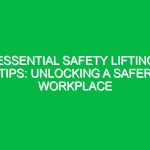Introduction
Hello everyone, and thank you for gathering here for today’s Toolbox Talk. As we prepare to start our work, it’s essential that we discuss an important health and Safety topic that can significantly impact our performance and well-being—Cold Stress. This talk is designed to equip you with knowledge and practical strategies to recognize, prevent, and respond to cold stress effectively. Let’s dive in!
What is Cold Stress?
Cold Stress occurs when the body loses heat faster than it can produce it, leading to a drop in body temperature. This condition can result from exposure to cold temperatures, wind, and wetness, which can impair our ability to work safely and efficiently. Understanding cold stress is critical, especially for those of us working outdoors or in unheated environments during colder months.
Why is Cold Stress Important in HSE?
Cold stress is not just a nuisance; it can lead to serious health issues, including:
- Hypothermia: A dangerously low body temperature that can affect brain function.
- Frostbite: Damage to skin and tissues due to freezing, which can lead to permanent injury.
- Trench Foot: A painful condition caused by prolonged exposure to wet and cold conditions.
Being aware of cold stress and its Effects is vital for maintaining a safe work Environment and ensuring that we all go home healthy at the end of the day.
Recognizing Cold Stress Symptoms
To combat cold stress effectively, we first need to recognize its symptoms. Here are some signs that you or a coworker may be experiencing cold stress:
- Shivering: This is the body’s initial response to cold.
- Fatigue: Feeling unusually tired can be a sign of energy depletion from shivering.
- Confusion: Difficulty concentrating or a sense of disorientation can indicate hypothermia.
- Numbness: Loss of feeling in extremities, especially fingers and toes, is a serious warning sign.
- Skin color changes: Skin may appear pale or waxy.
Recognizing these symptoms early can help in taking the necessary Precautions to prevent severe health consequences.
Factors Contributing to Cold Stress
Several factors can increase the risk of cold stress:
- Temperature: The lower the temperature, the higher the risk.
- Wind Chill: Wind can make it feel significantly colder than the actual temperature.
- Wet Conditions: Wet clothing or skin increases heat loss.
- Physical Activity: While activity generates heat, excessive sweating can lead to cooling if clothing becomes wet.
- Clothing: Inadequate or improper clothing can fail to provide necessary insulation.
Understanding these factors is crucial for both Prevention and response strategies.
Preventing Cold Stress
Preventing cold stress begins with preparation. Here are some essential tips to help reduce the risk:
1. Dress Appropriately
Wearing the right clothing is your first line of defense against cold stress. Consider the following:
- Layering: Use multiple layers to trap heat. A base layer to wick moisture, an insulating layer for warmth, and an outer layer to repel wind and moisture are ideal.
- Waterproof Gear: Ensure outer layers are waterproof to keep you dry and warm.
- Accessories: Don’t forget hats, gloves, and insulated footwear. Extremities lose heat quickly!
2. Take Regular Breaks
Schedule regular breaks in a warm area to give your body a chance to recover. During these breaks, warm up with a hot drink or snack to help maintain energy levels.
3. Stay Hydrated and Nourished
Even in cold weather, hydration is essential. Drink water regularly, and opt for warm beverages. Eating high-energy foods can also provide necessary fuel for maintaining body heat.
4. Monitor Each Other
Be aware of your coworkers. Look out for signs of cold stress in each other and encourage open communication about how everyone feels.
5. Know When to Seek Help
If you or someone you observe shows symptoms of cold stress, it’s crucial to seek help immediately. Early intervention can prevent severe health issues.
Responding to Cold Stress
In the event of cold stress symptoms becoming apparent, it’s essential to act quickly:
- Hypothermia: Move the person to a warm environment, remove wet clothing, and cover them with warm blankets. Provide warm, non-alcoholic drinks if they are conscious.
- Frostbite: Gradually warm the affected area using body heat or warm water (not hot). Seek medical attention promptly.
- Trench Foot: Warm the feet gradually and keep them dry. Change wet socks and boots as soon as possible.
Real-Life Scenarios
Let’s consider some hypothetical scenarios to illustrate the importance of recognizing and responding to cold stress:
Scenario 1: The Unprepared Worker
Imagine a worker, Alex, who arrives at the job site without proper winter gear. As the day progresses, he starts to feel cold but brushes it off. By mid-afternoon, Alex is shivering and confused. Had his coworkers noticed his symptoms and intervened early, he could have avoided serious complications.
Scenario 2: The Team Approach
Another scenario involves a team working outdoors during a particularly chilly day. They take turns monitoring each other’s conditions while ensuring they take regular breaks in a heated area. This proactive approach helps everyone stay warm and alert, reducing the risk of cold stress significantly.
Regulations and Standards
It’s also important to mention that various Regulations exist to ensure safe working conditions in cold environments. The Occupational Safety and Health Administration (OSHA) provides guidelines for employers to protect workers from cold stress. Complying with these regulations not only enhances Workplace Safety but also fulfills legal obligations.
Conclusion
In summary, Cold Stress is a serious concern that can affect anyone working in cold conditions. By understanding the risks, recognizing symptoms, and implementing prevention strategies, we can protect ourselves and our coworkers. Remember, every one of us plays a vital role in maintaining a safe working environment.
Thank you for your attention and commitment to Safety today. Let’s keep the conversation going, and feel free to share any experiences or strategies you have regarding cold stress. Together, we can ensure a safer workplace for everyone!


